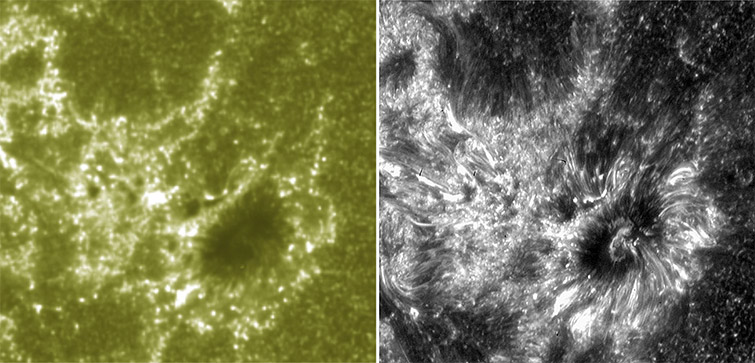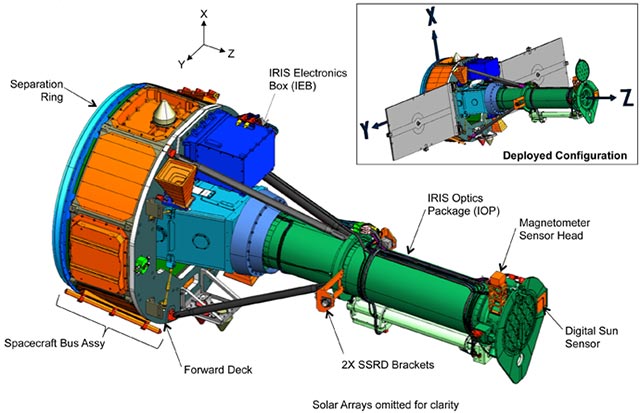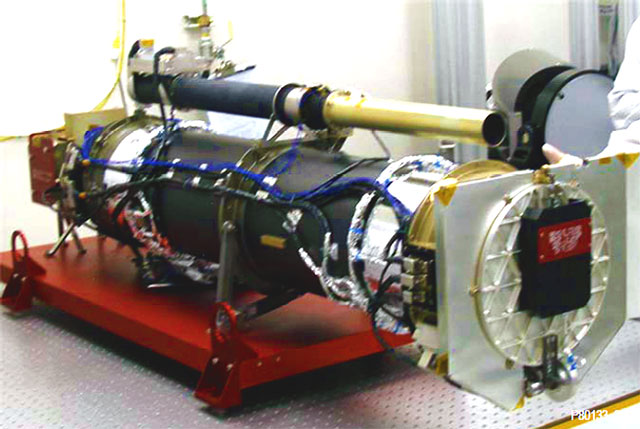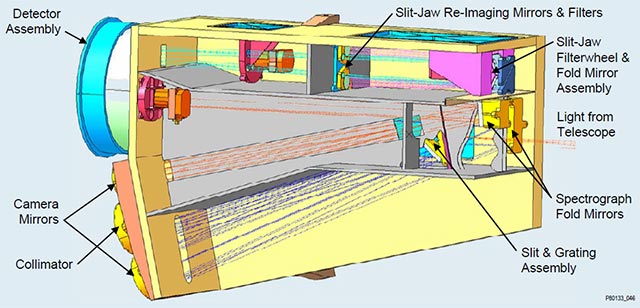Latest images from the Interface Region Imaging Spectrograph (IRIS)
IRIS Today: click to open
IRIS mission and instrument paper is now available for download: LINK
IRIS’ callibration and test videos
See the first videos from the IRIS spacecraft. These images will give you an idea of its capabilities:
![]() Prominence monitoring – large coarse 64-step raster
Prominence monitoring – large coarse 64-step raster
![]() Sunspot osscilation – medium sit-and-stare
Sunspot osscilation – medium sit-and-stare
![]() AR moss dynamics – large sit-and-stare
AR moss dynamics – large sit-and-stare
![]() Flare watch at west limb – large coarse 4-step raster
Flare watch at west limb – large coarse 4-step raster
![]() AR11899 2-step raster at 1400A
AR11899 2-step raster at 1400A
![]() Sit-n-stare North pole
Sit-n-stare North pole
![]() Active region flare observations
Active region flare observations
![]() Rapid dense raster of emerging flux region (AR11850)
Rapid dense raster of emerging flux region (AR11850)
![]() E Limb AR Flare Observations
E Limb AR Flare Observations
More videos to follow soon.
IRIS’ first image

These two images show a section of the sun as seen by NASA’s Interface Region Imaging Spectrograph, or IRIS, on the right and NASA’s SDO on the left. The IRIS image provides scientists with unprecedented detail of the lowest parts of the sun’s atmosphere, known as the interface region. (Credit: NASA/SDO/IRIS)
Here is a colour version of the same image from IRIS.
–
—
The spacecraft

IRIS is NASA’s Interface Region Imaging Spectrograph. Its primary goal is to understand how heat and energy move through the lower levels of the solar atmosphere.
IRIS is a class of spacecraft called a Small Explorer, which NASA defines as costing less than $120 million. Lockheed Martin (LM) Solar and Astrophysics Laboratory in LM’s Advanced Technology Center is the principle investigator institution and has overall responsibility for the mission, with major contributions from Lockheed Martin Civil Space, NASA Ames, Smithsonian Astrophysical Laboratory, Montana State University, Stanford University and the University of Oslo.
IRIS weighs 440 pounds. It is approximately 7 feet (2.1 meters) long and, with its solar panels extended, is a little over 12 feet (3.7 meters) across.
Telescope

IRIS carries a single instrument: an ultraviolet telescope combined with an imaging spectrograph. The telescope’s primary mirror has a diameter of about eight inches (20 cm). While it will only be able to see about one percent of the sun at a time, it will be able to resolve that image to show features that are as small as 150 miles (240 km) on the sun. Such high resolution will serve as a microscope for larger instruments that capture images of the whole sun simultaneously. IRIS will collaborate with NASA’s Solar Dynamics Observatory (SDO), for example, to target active regions on the sun.
The images from IRIS’s telescope will record observations of material at specific temperatures, ranging from 5000 K and 65,000 K (and up to 10 million K during solar flares). This range is tailored to observe material traveling on the surface of the sun, called the photosphere, and in the lowermost layers of the atmosphere, called the chromosphere and transition region.
The instrument will capture a new image every five to ten seconds, and spectra about every one to two seconds. These unique capabilities will be coupled with state of the art 3-D numerical modeling on supercomputers. Using both together, scientists will be able to trace how solar material at different temperatures courses through the chromosphere and transition region.
Spectrograph – Imager

Diagram of spectrograph and slit-jaw imager with part of the internal structure and baffling. Credit: NASA/LMSAL
Technical details
The far-UV channel covers:
1332-1358 Å and 1390-1406 Å with 40 m Å resolution and an effective area of 2.8 cm2.
The near-UV channel covers:
2785-2835 Å with 80 mÅ resolution and an effective area 0.3 cm2.
Slit-jaw imaging will have four passbands:
1335 Å and 1400 Å with 40 Å bandpass each
2796 Å and 2831 Å with 4 Å bandpass each
IRIS will have a high data rate (0.7 Mbit/s on average) so that the baseline cadence is: 5s for slit-jaw images, 1s for 6 spectral windows, including rapid rastering to map solar regions.
—
Courtesy of NASA/GSFC/LMSAL (IRIS)
IRIS is a NASA small explorer mission developed and operated by LMSAL with mission operations executed at NASA Ames Research center and major contributions to downlink communications funded by the Norwegian Space Center (NSC, Norway) through an ESA PRODEX contract.

